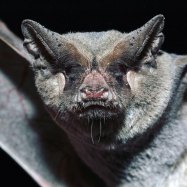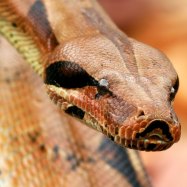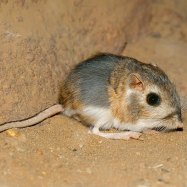
Burmese
Up to 18 feet
The Burmese Python, native to Southeast Asia, is a popular pet snake due to its stunning coloration and docile nature. However, in the United States, where it has been introduced, they can grow up to 18 feet in length and are posing a threat to native wildlife. These large and muscular snakes belong to the Pythonidae family and are best left to experienced handlers. #BurmesePython #SoutheastAsia #Pythonidae
Animal Details Summary:
Common Name: Burmese Python
Kingdom: Animalia
Habitat: Tropical rainforests, grasslands, swamps
The Magnificent Burmese Python: A Giant of the Tropical Rainforest
The natural world is filled with incredible creatures, each with their unique set of features and adaptations. Among the many remarkable animals, the graceful and mighty Burmese python stands out as an impressive and captivating species. With its striking coloration, impressive size, and fascinating behaviors, the Burmese python is a sight to behold.The scientific name of the Burmese python is Python bivittatus, and it belongs to the kingdom Animalia, making it a member of the animal kingdom Burmese. It is also categorized at the phylum Chordata, class Reptilia, and order Squamata, along with other snakes and reptiles. The Burmese python is part of the Pythonidae family, which is known to include some of the largest snake species in the world.
As the name suggests, the Burmese python is commonly found in Southeast Asia, particularly in Burma (now known as Myanmar). However, due to the exotic pet trade, these magnificent creatures have also been introduced to other parts of the world, including the United States. Let us take a closer look at this incredible species and discover what makes them stand out in the animal kingdom.
Habitat and Geographic Distribution
One of the most remarkable things about the Burmese python is its ability to adapt to various habitats. They are mainly found in the tropical rainforests of Southeast Asia, where they can thrive in the warm and humid climate. However, they are also known to inhabit other environments such as grasslands and swamps. This demonstrates their resilience and adaptability in different settings Blue Shark.In terms of their geographical distribution, the Burmese python is primarily found in Southeast Asia, particularly in countries like Myanmar, Vietnam, Thailand, and Indonesia. However, these magnificent creatures have also been introduced to the United States, where they have become an invasive species. They can now be found in states like Florida, where they are seen as a threat to the local ecosystem.
Appearance and Physical Characteristics
The Burmese python is a sight to behold, with its large and muscular body that can reach up to 18 feet in length. They are among the largest snake species in the world, with some individuals known to weigh over 200 pounds. Their body shape is cylindrical, with a thick and powerful build that helps them move and hunt with ease.One of the most striking features of the Burmese python is their coloration. They are famous for their light to dark brown scales, with irregular dark brown patches that cover their body. This pattern helps them blend into their surroundings, making them excellent ambush predators. They also have keen eyesight, which allows them to spot potential prey from a distance.
Feeding and Hunting Habits
As a carnivorous species, the Burmese python's diet consists mainly of small mammals, birds, and reptiles. With their impressive size and strength, they are capable of taking down prey much larger than themselves. They are known to hunt by ambushing their victims, with their quick and powerful strikes immobilizing their prey.One of the most fascinating things about the Burmese python's feeding habits is their ability to consume prey that is much larger than their head. This is due to their unique hinged jaw, which allows them to stretch their mouth and swallow their food whole. After a successful meal, these snakes can go without food for weeks, sometimes even months.
Behavior and Reproduction
The Burmese python is a solitary and mostly nocturnal species, preferring to hunt under the cover of darkness. However, during the breeding season, which occurs in the winter, they become more active during the day. Males engage in combat to compete for a female, and once a pair is formed, they will stay together for several months.After mating, the female Burmese python will lay a clutch of eggs, which she will incubate and protect until they hatch. These eggs take around three months to hatch, and the hatchlings are immediately independent and capable of hunting for themselves. However, only a small percentage of them will survive to adulthood, as they fall prey to predators and various environmental factors.
Threats and Conservation Efforts
The Burmese python population in its native range is facing numerous threats, including habitat destruction, hunting for their skin and meat, and capture for the exotic pet trade. In recent years, their population has also been affected by the emergence of the reptile skin trade, which has led to increased poaching.In Southeast Asia, the Burmese python is listed as a vulnerable species by the International Union for Conservation of Nature (IUCN). Various conservation efforts are underway to protect these magnificent creatures, including habitat preservation and stricter regulations on the pet trade. Additionally, awareness campaigns are being carried out to educate people about the importance of these snakes in their natural ecosystem.
Burmese Pythons as Pets
With their large size and intimidating appearance, some people might be surprised to learn that Burmese pythons are popular pets. However, before considering bringing one home, it is crucial to understand the responsibility and commitment that comes with owning such a magnificent creature. They require a lot of space, proper diet, and specialized care, making them best suited for experienced reptile owners.It is also essential to note that Burmese pythons are not suitable pets for everyone. Inexperienced owners may underestimate their strength and end up getting injured or overwhelmed. Moreover, releasing these exotic pets into the wild when they become too large to handle leads to environmental and ecosystem damage. Therefore, it is essential to thoroughly research and understand the implications of owning a Burmese python before bringing one into your home.
The Controversy Surrounding the Burmese Python in the United States
In their native range, Burmese pythons play an essential role in the tropical ecosystem, regulating prey populations and maintaining the balance of the food chain. However, in places like Florida, where they are considered an invasive species, they have become a cause for concern for wildlife conservationists and local authorities.The Burmese python population in Florida originated from escaped or released pets, and their numbers have grown exponentially in recent years. They pose a threat to native wildlife, including prey species like small mammals and birds, as well as other reptiles. Moreover, their large size and aggressive behavior have led to safety concerns for humans.
To address this issue, various measures have been put in place, including banning the sale and ownership of Burmese pythons in Florida. Additionally, wildlife officials have encouraged the public to report sightings and have implemented programs to capture and remove these snakes from the wild. However, the eradication of these pythons is a difficult task, and their impact on the Florida ecosystem is a matter of ongoing research and debate.
In Conclusion
The Burmese python is a truly remarkable species, with its size, coloration, and behavior making it stand out among other snakes. It is a vital part of the tropical ecosystem in its native range and continues to captivate and intrigue people worldwide. While they may not be suitable pets for everyone, there is no denying the awe-inspiring nature of these magnificent creatures. Let us strive to protect and preserve them so that future generations can continue to admire the beauty and wonder of the Burmese python.

Burmese
Animal Details Burmese - Scientific Name: Python bivittatus
- Category: Animals B
- Scientific Name: Python bivittatus
- Common Name: Burmese Python
- Kingdom: Animalia
- Phylum: Chordata
- Class: Reptilia
- Order: Squamata
- Family: Pythonidae
- Habitat: Tropical rainforests, grasslands, swamps
- Feeding Method: Carnivorous
- Geographical Distribution: Southeast Asia
- Country of Origin: Burma (Myanmar)
- Location: Southeast Asia, United States (introduced)
- Animal Coloration: Light to dark brown with irregular dark brown patches
- Body Shape: Large and muscular
- Length: Up to 18 feet

Burmese Python
- Adult Size: 6 to 10 feet
- Average Lifespan: 20 to 30 years
- Reproduction: Oviparous (lays eggs)
- Reproductive Behavior: Mating occurs once a year
- Sound or Call: Hisses and growls when threatened
- Migration Pattern: Non-migratory
- Social Groups: Solitary
- Behavior: Nocturnal
- Threats: Habitat loss, poaching
- Conservation Status: Lower Risk/Near Threatened
- Impact on Ecosystem: Predator on small mammals and birds
- Human Use: Pet trade, leather industry
- Distinctive Features: Large size, distinctive coloration
- Interesting Facts: Burmese pythons are one of the largest snake species in the world
- Predator: Humans, large predators like crocodiles and tigers

Python bivittatus
Burmese Pythons: The Giant Serpents of Myanmar
The Burmese python, scientifically known as Python bivittatus, is a stunning species of snake found in the tropical jungles and grasslands of Myanmar (formerly known as Burma). These impressive creatures have long fascinated humans with their size, beauty, and intriguing behaviors. In this article, we will explore the unique features of Burmese pythons and their impact on the ecosystems they inhabit.Adult Size and Average Lifespan
One of the most remarkable features of the Burmese python is its size PeaceOfAnimals.Com. These serpents can grow up to 6 to 10 feet in length, with some specimens reaching a whopping 25 feet. In captivity, Burmese pythons have been known to live for up to 30 years, while their lifespan in the wild is estimated to be around 20 years.
Reproduction and Reproductive Behavior
Burmese pythons are oviparous, meaning they lay eggs rather than giving birth to live young. Females typically lay 12-36 eggs per clutch, which they guard fiercely until the eggs hatch. Mating occurs only once a year, usually during the cooler months from December to March, and can last for several hours.
Sound or Call and Social Groups
These giant reptiles are generally solitary creatures, preferring to spend their time alone rather than in social groups. When threatened, they are known to hiss and growl, creating a distinct sound that can be heard from a considerable distance.
Migration Pattern and Behavior
Unlike some other snake species, Burmese pythons do not migrate and prefer to stay in one area throughout their lives. They are mostly nocturnal, meaning they are most active during the night, but they have also been observed basking in the sun during the daytime British Timber.
Threats and Conservation Status
Unfortunately, Burmese pythons face numerous threats in their natural habitat. One major threat is habitat loss due to deforestation and human development. Additionally, these snakes are highly sought after for their skin in the leather industry, and they are also popular pets in the exotic pet trade. These factors have landed them on the International Union for Conservation of Nature's (IUCN) Lower Risk/Near Threatened list.
Impact on Ecosystem
Burmese pythons play a crucial role in the ecosystems they inhabit. As apex predators, they are key in controlling the populations of small mammals and birds, which helps to maintain a healthy balance in the food chain. Their presence also helps regulate the population of pests, such as rats and mice, which can cause damage to crops.
Human Use and Distinctive Features
Despite their critical role in ecosystems, humans have also exploited Burmese pythons for their own use. These snakes are highly sought after in the exotic pet trade, with some individuals fetching high prices due to their unique coloration and massive size. Their skins are also used in the leather industry, contributing to their declining population in the wild.
Burmese pythons are also known for their distinctive features, making them easily recognizable. These include their large size, typically light-colored or brown bodies with dark, bold patterns, and their triangular head shape. In some instances, albino Burmese pythons with yellow or white scales have also been spotted.
Interesting Facts
Apart from their size and distinctive coloration, there are some other interesting facts about Burmese pythons that make them stand out among other snake species. Did you know that these giants possess vestigial hind limbs, which are remnants of their evolution from a four-legged ancestor? These tiny claws can be seen near their cloacal area during dissections.
Additionally, Burmese pythons have amazing heat-sensing abilities due to the presence of infrared sensors on their lower lip. This helps them locate prey, even in the dark, by detecting their body heat. They also have strong muscles that enable them to constrict their prey, squeezing it to death before swallowing it whole.
Predators
In the wild, Burmese pythons have few natural predators due to their tremendous size and powerful constricting abilities. However, they are not invincible and can still be preyed upon by large predators such as crocodiles and tigers. Unfortunately, the biggest threat to these magnificent creatures is humans, who hunt them for their skin and also pose a threat through habitat destruction.
The Plight of Burmese Pythons
The Burmese python population has faced a significant decline in recent years, mainly due to human activities and climate change. Their natural habitat is being destroyed at an alarming rate, and they are often hunted for their skin. As a result, some governments in Southeast Asia, where the species is native, have put in place laws to protect them from poachers and regulate their trade.
In Florida, where the Burmese python is an invasive species, the government has implemented measures to control their population, as they pose a threat to native wildlife. The state even has an annual "Python Challenge" where hunters are encouraged to capture and remove these snakes from the Everglades National Park.
In Conclusion
The Burmese python is a beautiful and fascinating species of snake, with unique features and behaviors that have captured the interest of humans for centuries. However, their population is declining due to human activities, and it is our responsibility to protect and conserve these magnificent creatures for future generations.
With proper conservation efforts and stricter laws against poaching and illegal trade, we can ensure that these giant serpents continue to play their critical role in maintaining a healthy balance in the ecosystems they inhabit. So let us appreciate and admire the Burmese python from a distance, without causing harm, and do our part in preserving their existence on our planet.

The Magnificent Burmese Python: A Giant of the Tropical Rainforest
Disclaimer: The content provided is for informational purposes only. We cannot guarantee the accuracy of the information on this page 100%. All information provided here may change without prior notice.












